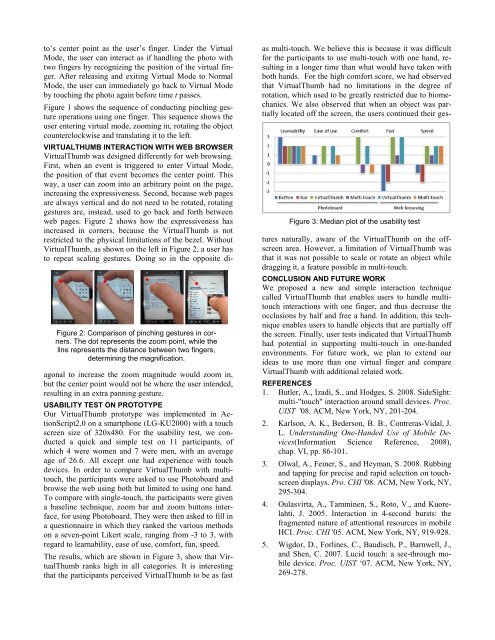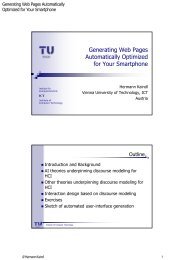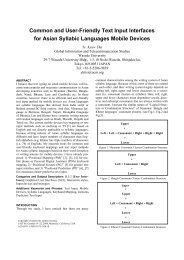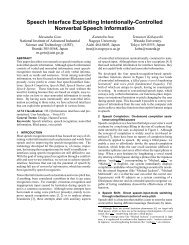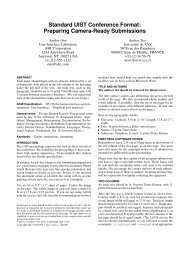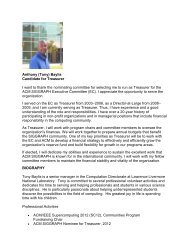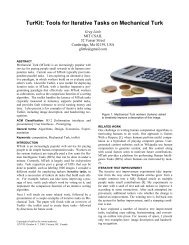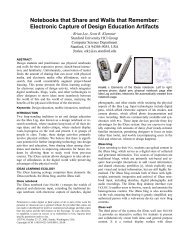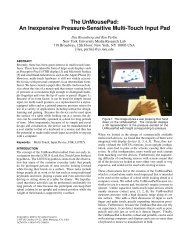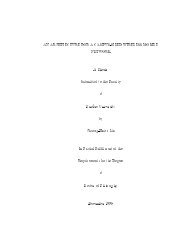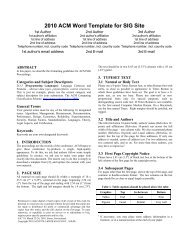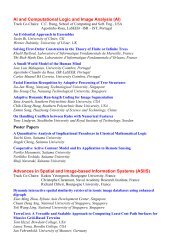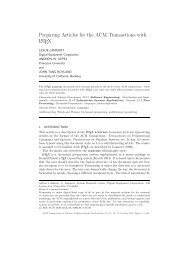One-Handed Multi-Touch Emulation Technique on Small ... - ACM
One-Handed Multi-Touch Emulation Technique on Small ... - ACM
One-Handed Multi-Touch Emulation Technique on Small ... - ACM
You also want an ePaper? Increase the reach of your titles
YUMPU automatically turns print PDFs into web optimized ePapers that Google loves.
to’s center point as the user’s finger. Under the Virtual<br />
Mode, the user can interact as if handling the photo with<br />
two fingers by recognizing the positi<strong>on</strong> of the virtual finger.<br />
After releasing and exiting Virtual Mode to Normal<br />
Mode, the user can immediately go back to Virtual Mode<br />
by touching the photo again before time t passes.<br />
Figure 1 shows the sequence of c<strong>on</strong>ducting pinching gesture<br />
operati<strong>on</strong>s using <strong>on</strong>e finger. This sequence shows the<br />
user entering virtual mode, zooming in, rotating the object<br />
counterclockwise and translating it to the left.<br />
VIRTUALTHUMB INTERACTION WITH WEB BROWSER<br />
VirtualThumb was designed differently for web browsing.<br />
First, when an event is triggered to enter Virtual Mode,<br />
the positi<strong>on</strong> of that event becomes the center point. This<br />
way, a user can zoom into an arbitrary point <strong>on</strong> the page,<br />
increasing the expressiveness. Sec<strong>on</strong>d, because web pages<br />
are always vertical and do not need to be rotated, rotating<br />
gestures are, instead, used to go back and forth between<br />
web pages. Figure 2 shows how the expressiveness has<br />
increased in corners, because the VirtualThumb is not<br />
restricted to the physical limitati<strong>on</strong>s of the bezel. Without<br />
VirtualThumb, as shown <strong>on</strong> the left in Figure 2, a user has<br />
to repeat scaling gestures. Doing so in the opposite di-<br />
Figure 2: Comparis<strong>on</strong> of pinching gestures in corners.<br />
The dot represents the zoom point, while the<br />
line represents the distance between two fingers,<br />
determining the magnificati<strong>on</strong>.<br />
ag<strong>on</strong>al to increase the zoom magnitude would zoom in,<br />
but the center point would not be where the user intended,<br />
resulting in an extra panning gesture.<br />
USABILITY TEST ON PROTOTYPE<br />
Our VirtualThumb prototype was implemented in Acti<strong>on</strong>Script2.0<br />
<strong>on</strong> a smartph<strong>on</strong>e (LG-KU2000) with a touch<br />
screen size of 320x480. For the usability test, we c<strong>on</strong>ducted<br />
a quick and simple test <strong>on</strong> 11 participants, of<br />
which 4 were women and 7 were men, with an average<br />
age of 26.6. All except <strong>on</strong>e had experience with touch<br />
devices. In order to compare VirtualThumb with multitouch,<br />
the participants were asked to use Photoboard and<br />
browse the web using both but limited to using <strong>on</strong>e hand.<br />
To compare with single-touch, the participants were given<br />
a baseline technique, zoom bar and zoom butt<strong>on</strong>s interface,<br />
for using Photoboard. They were then asked to fill in<br />
a questi<strong>on</strong>naire in which they ranked the various methods<br />
<strong>on</strong> a seven-point Likert scale, ranging from -3 to 3, with<br />
regard to learnability, ease of use, comfort, fun, speed.<br />
The results, which are shown in Figure 3, show that VirtualThumb<br />
ranks high in all categories. It is interesting<br />
that the participants perceived VirtualThumb to be as fast<br />
as multi-touch. We believe this is because it was difficult<br />
for the participants to use multi-touch with <strong>on</strong>e hand, resulting<br />
in a l<strong>on</strong>ger time than what would have taken with<br />
both hands. For the high comfort score, we had observed<br />
that VirtualThumb had no limitati<strong>on</strong>s in the degree of<br />
rotati<strong>on</strong>, which used to be greatly restricted due to biomechanics.<br />
We also observed that when an object was partially<br />
located off the screen, the users c<strong>on</strong>tinued their ges-<br />
Figure 3: Median plot of the usability test<br />
tures naturally, aware of the VirtualThumb <strong>on</strong> the offscreen<br />
area. However, a limitati<strong>on</strong> of VirtualThumb was<br />
that it was not possible to scale or rotate an object while<br />
dragging it, a feature possible in multi-touch.<br />
CONCLUSION AND FUTURE WORK<br />
We proposed a new and simple interacti<strong>on</strong> technique<br />
called VirtualThumb that enables users to handle multitouch<br />
interacti<strong>on</strong>s with <strong>on</strong>e finger, and thus decrease the<br />
occlusi<strong>on</strong>s by half and free a hand. In additi<strong>on</strong>, this technique<br />
enables users to handle objects that are partially off<br />
the screen. Finally, user tests indicated that VirtualThumb<br />
had potential in supporting multi-touch in <strong>on</strong>e-handed<br />
envir<strong>on</strong>ments. For future work, we plan to extend our<br />
ideas to use more than <strong>on</strong>e virtual finger and compare<br />
VirtualThumb with additi<strong>on</strong>al related work.<br />
REFERENCES<br />
1. Butler, A., Izadi, S., and Hodges, S. 2008. SideSight:<br />
multi-"touch" interacti<strong>on</strong> around small devices. Proc.<br />
UIST '08. <strong>ACM</strong>, New York, NY, 201-204.<br />
2. Karls<strong>on</strong>, A. K., Beders<strong>on</strong>, B. B., C<strong>on</strong>treras-Vidal, J.<br />
L. Understanding <str<strong>on</strong>g>One</str<strong>on</strong>g>-<str<strong>on</strong>g>Handed</str<strong>on</strong>g> Use of Mobile Devices(Informati<strong>on</strong><br />
Science Reference, 2008),<br />
3.<br />
chap. VI, pp. 86-101.<br />
Olwal, A., Feiner, S., and Heyman, S. 2008. Rubbing<br />
and tapping for precise and rapid selecti<strong>on</strong> <strong>on</strong> touchscreen<br />
displays. Pro. CHI '08. <strong>ACM</strong>, New York, NY,<br />
295-304.<br />
4. Oulasvirta, A., Tamminen, S., Roto, V., and Kuorelahti,<br />
J. 2005. Interacti<strong>on</strong> in 4-sec<strong>on</strong>d bursts: the<br />
fragmented nature of attenti<strong>on</strong>al resources in mobile<br />
HCI. Proc. CHI '05. <strong>ACM</strong>, New York, NY, 919-928.<br />
5. Wigdor, D., Forlines, C., Baudisch, P., Barnwell, J.,<br />
and Shen, C. 2007. Lucid touch: a see-through mobile<br />
device. Proc. UIST ‘07. <strong>ACM</strong>, New York, NY,<br />
269-278.


